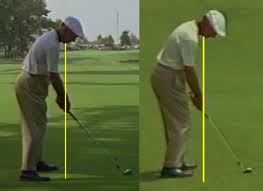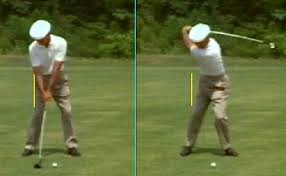Weight Transfer Path – The weight moves along the ankle line’
Weight shift (from the left to the right side) is a key aspect of the golf swing, However, there is more than way to attain this weight-shift. A lot depends on your stance – and where your ‘upper body weight ‘falls’. For a forward leaning stance, the upper body weight ‘falls’ slightly in front of the toe line. For a ‘sitting down’ stance, the upper body weight falls more on top of the foot (closer to the ankles).
This initial stance will dictate the ‘line’ along which your weight shifts. For the purposes of this post, we can refer to this imaginary line as the ‘weight shift line’ ( a straight line – running from the left side of the body to the right – across which one can visualize the weight shifting ).
Toe Line , Heel Line and Ankle Line – Now that we can visualize a line along which the weight shift occurs, it makes a little more sense to talk about the ‘toe line’ ‘heel line’ and the ‘Ankle Line’. The Ankle-line is simply a line running from the left ankle to the right (ankle line); a line running from the left toe to the right is the toe line – and so on. The ‘heel line’ (from the left heel to the right heel) and the ‘ball line’ (ball of left foot to ball of right foot) are two commonly illustrated lines. There are also mix-and-match options – a line starting from the left ball of the foot to the right heel of the foot.
The Correct Weight Shift Line
Imagine drawing a line from the top of the left foot ankle to the top of the right. That is the line across which your weight shift needs to occur. As discussed above, the upper body weight needs to start out resting on this line. To start with, your weight needs to be on the left ankle – i.e. your left shoulder (front) – falls directly over the left foot (top) and the right shoulder (front) falls directly over the right foot (top). This way, you start with your weight positioned across the correct line. Now, if you simply turn your upper body from left to right, you will end up shifting across this weight line.

The Significance of the ‘Weight Shift’ Line (the inside-out path)
By now, you have probably heard a zillion times that the correct downswing is one that follows an inside-out (inside of the target line) path. This is the ONLY way to hit ANY golf shot , regardless of the type of shot or the club being used. Any other path (out to out, out to in…) leads to skewed shots (either a slice or a hook or something worse!).
The Body Clearance Concept
Now that we realize that the downswing has to come from an inside-out path (from inside the target line), what backswing position will help us start the club on this inside-out path? On completion of our backswing, we should feel a ‘clearance’ in front of our body. This ‘clearance’ provides space for the arms to swing freely in front of the body. If executed correctly, swinging the arms in front of the body feels just like a solid tennis backhand shot (where you need an inside out path as well). Here is a recent post on Rory McLRoy’s swing secrets – body clearance being a key component of his explosive swing.
Summary
Try and feel where your upper body weight ‘falls’ as you take your stance. It should not feel too far forward or too far back (using the toe-line as a reference line). Just slightly behind the toe line (the ankle line) is perfect. From here , as long as you don’t wildly swing back , a smooth turn will guarantee a shift across the ankle line – leading to a correct weight transfer.
Afterthought – Hogan’s Hip Tip

Hogan suggests picturing an umbrella leaning against your right leg and MAINTAINING the angle of the umbrella throughout the backswing (throughout the weight transfer). This actually FORCES your weight to transfer (shift) along the foot line – any other path will lead to a ‘sway’ (lateral movement of hips). To avoid a sway, the right hip needs to maintain its tilt and act as an anchor –a s seen in Hogan’s picture above.
Several famous golfers use the right hip as their backswing anchor; some talk about the right knee – however, I believe they are one and the same thing. If you can keep your right knee from swaying, you are most likely keeping your right hip angle as well.
Leave a Reply